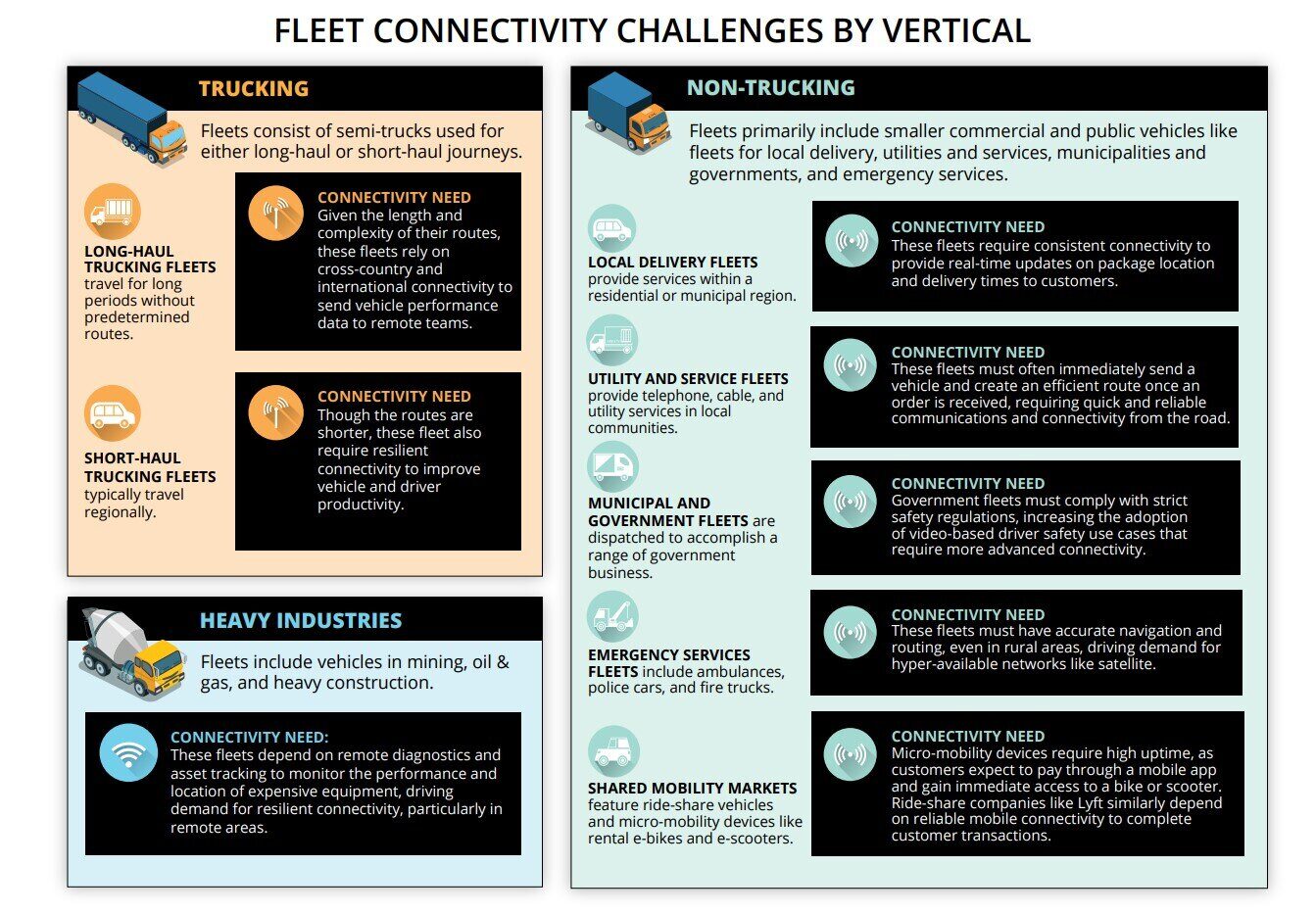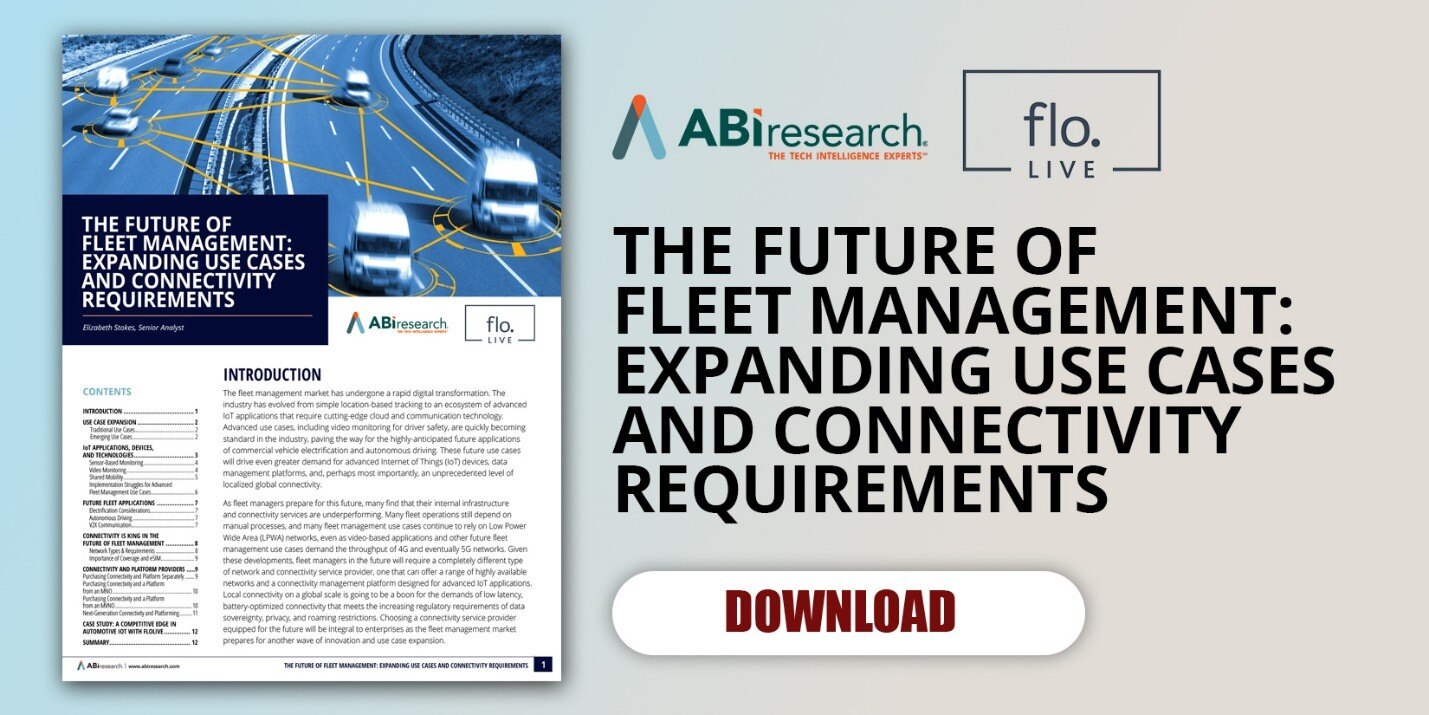Fleet management has experienced transformational advancements in digitalization over the past 2 decades. Primordial applications like vehicle tracking have evolved into real-time performance monitoring and video telematics. Current technology providers are continuing to push the innovation envelope, driving fleet management into another era of transformation.
Emerging trends like fleet electrification, autonomous driving, and Vehicle-to-Everything (V2X) communication are on the horizon. These applications demand more robust data management and wireless connectivity solutions than most fleet managers currently use. To ensure support for forward-looking use cases, enterprises must carefully choose their connectivity partner.
Download FREE Whitepaper: The Future of Fleet Management

(Source: ABI Research)
Future Fleet Management Applications
Electrification Considerations
The transportation sector is rapidly moving toward Electric Vehicles (EVs), with forecasts indicating that, by 2030, there will be around 3 million commercial EVs on the road. For fleet managers, this shift creates significant operational changes. They must analyze historical data from gasoline or diesel vehicles to anticipate how routes, fuel consumption, and fleet lifecycles will change when adopting EVs. Moreover, electrification creates a surge in telematics data, making it essential to have cloud applications capable of processing these data in real time to ensure fleet efficiency and visibility.
Low latency in EV communication is key. It allows real-time responses to changes in vehicle performance and environmental conditions, improving vehicle safety and enhancing critical functions like adaptive driving assistance and collision avoidance. As fleet electrification accelerates, ensuring seamless, low-latency connectivity will become vital.
Further Reading: Selecting the Right Electric Vehicle (EV) Manufacturer for a Commercial Fleet
Autonomous Driving
While fully autonomous commercial fleets may still be years away, semi-autonomous technologies like Advanced Driver-Assistance Systems (ADAS) are already here. These systems, which include automated steering and braking, collect vast amounts of data. As automation levels increase (from Level 1 to Level 5), the data flow will intensify. In the future, fully autonomous fleets will require ultra-reliable, low-latency connectivity to ensure safe and efficient operations.
As these technologies evolve, fleet managers must analyze complex Internet of Things (IoT) data, video feeds, and vehicle diagnostics. The rise of autonomous driving will change the nature of fleet management, forcing fleet operators to adopt advanced connectivity solutions that can handle massive volumes of real-time data.
Vehicle-to-Everything (V2X) Communication
V2X technology allows vehicles to communicate with infrastructure, other vehicles, and consumer devices. By enabling trucks to transmit data to road signs, traffic lights, and even pedestrians, V2X can improve road safety, enhance traffic coordination, and reduce fuel consumption. However, the success of V2X implementation hinges on reliable, widespread cellular connectivity—most likely through 4G and 5G networks.
It should be noted that V2X is a more far-off application than the previous two; it won’t become a reality for a while. Nevertheless, when the time comes for V2X to become integrated into transportation systems, fleet managers need robust IoT device connectivity. A borderless, low-latency connectivity solution will ensure that trucks communicate effectively with the surrounding environment. The widespread adoption of V2X will depend on strong partnerships between fleet operators and connectivity providers that can ensure uninterrupted data transmission.
Connectivity Options for Future Fleet Applications
Fleet operators have four main connectivity options to support future applications. Each has its own advantages and challenges. Selecting the right connectivity approach is crucial for ensuring that fleets can manage data-intensive applications, from EV performance monitoring to autonomous vehicle operations.
1. Purchasing Connectivity and Platform Separately
Some fleet managers purchase connectivity services and a Connectivity Management Platform (CMP) from different suppliers. This approach can give operators greater flexibility, allowing them to select the best options for their specific needs.
On the downside, integrating the two solutions separately is not ideal for most enterprises because it requires significant time, resources, and expertise. Large enterprises with the capacity to manage complex integrations might find this approach useful, but it is generally more time-consuming and costly.
2. Purchasing Connectivity and Platform from an MNO
Mobile Network Operators (MNOs) offer both connectivity and connectivity platform solutions, often as part of a bundled package. This may seem attractive if your fleet operates in a single country, as MNOs are well-established and often have longstanding relationships with their national customers.
However, your fleet likely crosses borders and may even operate globally. Unfortunately, MNOs are typically limited by their geographic reach and may not offer seamless international connectivity. For fleets that operate across borders, this approach can lead to coverage gaps and inconsistent service quality.
3. Purchasing Connectivity and Platform from an MVNO
Mobile Virtual Network Operators (MVNOs) offer an alternative to traditional MNOs by providing a more flexible, global solution. MVNOs aggregate connectivity across multiple networks, giving fleet managers access to a broader coverage area and more consistent service across regions. They can aggregate many operator networks on a single Subscriber Identity Module (SIM) and create a global coverage portfolio.
MVNOs also combine these networks into a unified platform, offering seamless connectivity management regardless of location. This approach is well-suited for fleets that operate internationally or need guaranteed connectivity for data-heavy, mobile applications like real-time monitoring and V2X communication.
Despite the benefits of partnering with an MVNO, future fleet management use cases will demand more advanced connectivity solutions. As the market propels forward, fleet managers will seek next-generation providers that blend the strengths of both MNOs and MVNOs. Connectivity service providers must deliver ultra-low latencies and effective localized yet global performance, ensuring seamless connectivity across various networks, countries, and device types. This capability will be essential for managing increasingly complex fleet operations.
4. Choosing a Next-Generation Connectivity Provider
As fleet management use cases continue to evolve, the need for next-generation connectivity solutions becomes more apparent. These connectivity providers combine the best features of both MNOs and MVNOs, offering global, high-performance connectivity with ultra-low latencies.
By building a global network of local Points of Presence (PoPs), next-gen connectivity providers can deliver fast, reliable connections anywhere in the world. This type of connectivity is essential for emerging fleet management applications. Video monitoring, EV performance tracking, and autonomous driving require uninterrupted, real-time data transmission. Choosing strictly an MNO or an MVNO carries the risk of connectivity hindrances that disrupt logistical flow.
Next-gen connectivity providers also offer advanced CMPs that give fleet managers granular control over their vehicles, monitoring data usage, device behavior, and connectivity performance. These platforms can also manage Over-the-Air (OTA) updates and perform continuous security checks. These platforms provide the comprehensive support needed for future fleet operations.
More Fleet Data Necessitate Better Connectivity
As fleet management evolves, IoT connectivity demands will continue to grow. Future fleet applications like electrification, autonomous driving, and V2X communication generate massive amounts of data that must be processed and analyzed in real time. Traditional connectivity solutions won’t get the job done.
Fleet managers should partner with next-generation connectivity platforms that offer global, reliable, and low-latency solutions. By partnering with the right IoT connectivity service provider, fleets can ensure seamless data transmission and fully capitalize on the benefits of emerging fleet applications.
As the fleet industry edges closer to a new technological revolution, learn more about future connectivity requirements in ABI Research’s whitepaper, The Future of Fleet Management: Expanding Use Cases and Connectivity Requirements.

